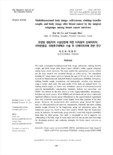

PARTNER
검증된 파트너 제휴사 자료
Multidimensional body image, self-esteem, clothing benefits sought, and body image after breast cancer by the surgical subgroups among breast cancer survivors
17 페이지
최초등록일 2023.04.05
최종저작일
2016.12

-
 * 본 문서는 배포용으로 복사 및 편집이 불가합니다.
* 본 문서는 배포용으로 복사 및 편집이 불가합니다.
미리보기
서지정보
· 발행기관 : 복식문화학회
· 수록지 정보 : 복식문화연구 / 24권 / 6호
· 저자명 : Eun Ok Lee, YoungJu Rhee
영어초록
This study investigated multidimensional body image, self-esteem, clothing benefits sought, and Body Image After Breast Cancer (BIABC) within surgical subgroups among breast cancer survivors. The study applied the questionnaire survey method and the main research was conducted through an online survey. The respondents included 207 breast cancer survivors between the ages of 30 and 59, each of whom received the Multidimensional Body-Self Relations Questionnaire (MBSRQ). Self-esteem, clothing benefits sought, examination, and demographic variables were measured using a 5-point Likert scale. The main results of this study are outlined below. For clothing benefit sought, six factors were formulated—pursuit of self-expression/social approval, function/health, compensation, femininity, fashion, and camouflage—and BIABC was defined by the four factors of body stigma/vulnerability, transparency, limitation and cancer concern. While MBSRQ and self-esteem did not show a statistically significant difference between groups differentiated by the surgical methods experienced, those who underwent mastectomies scored slightly lower than members of the other groups. Moreover, the reconstruction after mastectomy group showed the highest mean on self-expression/social approval, compensation, femininity and entire clothing benefits sought, followed by the lumpectomy group and mastectomy group. The lumpectomy group was found to have more positive BIABC than the mastectomy group. In particular, the mastectomy group showed a lower body stigma/vulnerability mean than the other groups. This study is meaningful in that it improves our understanding of the body image of breast cancer survivors and provides basic knowledge for developing products and marketing strategies for breast cancer survivors as consumers.참고자료
· 없음태그
-
자료후기
-
자주묻는질문의 답변을 확인해 주세요

꼭 알아주세요
-
본 학술논문은 (주)코리아스칼라와 각 학회간에 저작권계약이 체결된 것으로 AgentSoft가 제공 하고 있습니다.
본 저작물을 불법적으로 이용시는 법적인 제재가 가해질 수 있습니다. -
해피캠퍼스는 구매자와 판매자 모두가 만족하는 서비스가 되도록 노력하고 있으며, 아래의 4가지 자료환불 조건을 꼭 확인해주시기 바랍니다.
파일오류 중복자료 저작권 없음 설명과 실제 내용 불일치 파일의 다운로드가 제대로 되지 않거나 파일형식에 맞는 프로그램으로 정상 작동하지 않는 경우 다른 자료와 70% 이상 내용이 일치하는 경우 (중복임을 확인할 수 있는 근거 필요함) 인터넷의 다른 사이트, 연구기관, 학교, 서적 등의 자료를 도용한 경우 자료의 설명과 실제 자료의 내용이 일치하지 않는 경우
“복식문화연구”의 다른 논문도 확인해 보세요!
-
Expressive characteristics of genderless style appeared in contemporar.. 17 페이지
-
Symmetry, ratio and proportion in Scottish clan tartans 13 페이지
-
The effects of Chinese tourists friendliness toward Korean culture and.. 19 페이지
-
A study of the influences of Malevichs Victory Over the Sun on contemp.. 15 페이지
-
The effects of salespersons self-determination, shared value, and comm.. 14 페이지
문서 초안을 생성해주는 EasyAI
